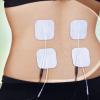CYBERMED LIFE - ORGANIC & NATURAL LIVING
CYBERMED LIFE - ORGANIC & NATURAL LIVING
 Electric stimulation: Electric stimulation therapy is a therapeutic treatment that applies electrical stimulation in treating muscle spasms and pain. It can help prevent atrophy and build strength in patients with injuries. It is also helpful in keeping muscles active especially after any type spinal cord injury or strokes.
Electric stimulation: Electric stimulation therapy is a therapeutic treatment that applies electrical stimulation in treating muscle spasms and pain. It can help prevent atrophy and build strength in patients with injuries. It is also helpful in keeping muscles active especially after any type spinal cord injury or strokes.
Physical therapists and other medical practitioners attach electrodes on the patient’s skin, causing the target muscles to contract. With electric stimulation, the patient can maintain muscle tone and strength that would otherwise waste away due to lack of usage.
Electric stimulation works by mimicking the natural way by which the body exercises its muscles. The electrodes attached to the skin deliver impulses that make the muscles contract. It is beneficial in increasing the patient’s range of motion and improves the circulation of the body. It is used in treating conditions like sprains, arthritis, back pain scoliosis and sciatica.
Electric stimulation can be muscular, general and transcutaneous electrical nerve stimulation (TENS). The muscular type of electric stimulation seeks to strengthen the muscles by reducing muscle spasms. Also known as EMS, this stimulates the skeletal muscle using electric impulses to cause muscle contraction.
TENS is commonly used to help with chronic pain. The general type of electric stimulation is used for healing wounds and alleviating pain. For the convenience of the patient, a portable TENS unit can be prescribed by the doctor or a physical therapist for the patient to use at home.
Interferential current (IFC) is another form of TENS. It is used by physical therapists and chiropractors for the purpose of decreasing inflammation and swelling of affected tissues. This treatment has also shown positive effects in improving symptoms of asthma and in reducing back pain.
Galvanic stimulation is also another application of electric stimulation. This involves applying pulsed electric current on affected body tissues in stimulating muscle contraction. It differs with TENS and IFC in its use of direct current rather than alternating current. The positive pad acts to decrease circulation of the target area and reduce swelling. The negative pad increases the distribution of oxygen, blood and nutrients to the injured area thus increasing the speed of the healing process.